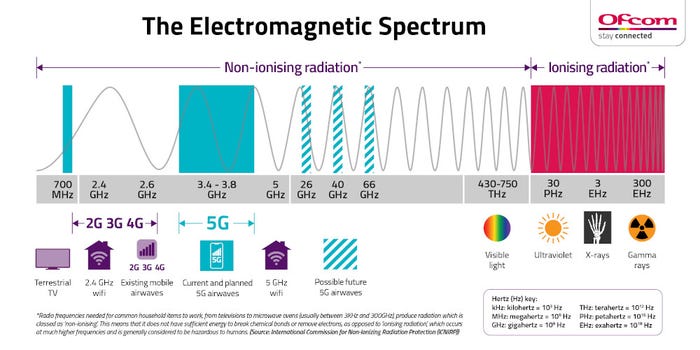Ofcom fails to clear up the myths around 5G and the coronavirusOfcom fails to clear up the myths around 5G and the coronavirus
UK telecoms regulator Ofcom has published an announcement that claims to rebut the conspiracy theories regarding 5G and coronavirus, but barely mentions them.
April 20, 2020

UK telecoms regulator Ofcom has published an announcement that claims to rebut the conspiracy theories regarding 5G and coronavirus, but barely mentions them.
The piece, entitled ‘Clearing up the myths around 5G and the coronavirus’, starts promisingly. “There is a conspiracy theory that claims 5G is connected to the spread of the coronavirus (Covid-19),” it states. “This is wrong. There is no scientific basis or credible evidence for these claims.” But then it goes on to note that burning down phone masts can reduce connectivity and then address the persistent ‘does 5G give you cancer?’ question.
Those two topics are definitely important, but they don’t in any way address the mistaken belief that 5G is in some way contributing to the spread of coronavirus. The very simple fact is that physical particles cannot be transmitted over electromagnetic waves. That piece of fundamental education should be front and centre of any fact-checking campaign, and yet Ofcom chose not to mention it at all.
If, for whatever reason, Ofcom was disinclined to consult scientific experts in the preparation of its announcement, it could at least have linked to other sources that put a bit more effort into debunking this silliness. An obvious choice would have been Full Fact, which calls itself the UK’s independent fact checking charity, and seems as impartial as any.
At the end of March Full Fact addressed a story published by the Daily Star, originally headlined ‘Fears 5G wifi networks could be acting as ‘accelerator’ for disease’. While it doesn’t even attempt to correct the sloppy conflation of cellular and wifi networks, it does have a fairly comprehensive look at a couple of specific allegations.
The first is that radio waves may in some way inhibit the immune system, thus increasing the chance of infection. This is easily addressed by the broader topic concerning the effects of electromagnetic radiation on the human body. Here, it must be said, the Ofcom piece does add some value by reproducing the good old electromagnetic spectrum diagram. Additionally it stresses that only ionizing radiation penetrates cells and that’s at the other end of the spectrum from radio waves.

The other physiological matter Ofcom does address is the fact that longer wavelength radiation does transfer heat – hence microwave ovens and infrared bulbs. Nobody wants their brain cooked while they’re on a call, so this matter has been researched extensively, resulting in the recent release of guidelines to ensure that doesn’t happen. The most useful part of the Ofcom announcement reveals its recent studies have found UK 5G base stations operate at a tiny fraction of the maximum levels stipulated by the International Commission on Non‐Ionizing Radiation Protection.
The second claim addressed by the Full Fact rebuttal is just downright amusing, that viruses talk to each other when making decisions about infecting a host. This paints a picture of viruses perched, en masse, on a phone tower, surveying the unwitting local population below and then having a vote about which poor sod to infect.
The only evidence presented for this entertaining theory is a single study from eight years ago that reckoned E Coli bacteria might emit electromagnetic radiation. It concluded “There is considerable work required to extract the bioinformation contained in these electromagnetic signals,” but none of the researchers seem to have considered that work worth doing in the subsequent years. Bacteria, or course, are not viruses.
Another good effort at exposing some of the crazy talk flying around the internet in spite of feeble attempts at censorship was recently published by Science Alert. It, too, addresses the nature of electromagnetic radiation and how it can’t transmit physical particles. Also mentioned is the likelihood that fear and general distrust of government are key factors in persuading people to cling to crackpot theories such as these.
That phenomenon was recently explored in a piece published by The Critic entitled ‘Conspiracies in the time of Coronavirus,’ which revealed that even supposedly ‘trusted’ sources can be seduced by the dark side at times like this. “Human beings, confronted with an infodemic as much as a pandemic, try to sort information of extremely varied quality into categories to ‘make sense’ of their situation, concludes the piece. “Conspiracy theories have a pleasant neatness that makes this process easier.”
As we will never tire of stressing, misleading speech needs to be countered by rational, evidence-based argument. Ofcom was right to address this lunacy but did so in a slipshod and incomplete way, not even linking to the supposedly definitive WHO. In that sense Ofcom is representative of broader society and demonstrated that the considerable resources currently being pumped into censorship would be achieve far more positive outcomes if spent on public education instead.
About the Author
You May Also Like










.png?width=300&auto=webp&quality=80&disable=upscale)


_1.jpg?width=300&auto=webp&quality=80&disable=upscale)